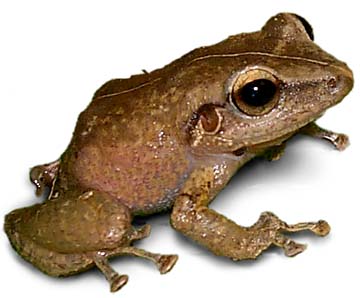
COURTESY PHOTO
Noisy coqui frogs have been a nuisance all over the state.
Workers will spray
to rid Wahiawa
of coqui frogs
On Monday night, state and federal workers armed with 100-gallon motorized sprayers filled with a citric acid solution plan to attack an infestation of coqui frogs on nine acres in Wahiawa.
They are prepared to use 800 to 900 gallons of the chemical spray in what will be the largest coqui frog kill on Oahu.
"This is the only wild population on Oahu," said Scott Williamson, invasive species technician with Department of Land & Natural Resources' Forestry and Wildlife Division.
The noisy frogs have been a nuisance at nurseries in Haleiwa, Kahaluu and Waimanalo, but the problem has been contained, officials said. The coqui, which are native to Puerto Rico, is believed to have spread by stowing away on nursery plants.
Government agencies hope to ultimately eradicate the invasive frogs on Oahu and avoid a repeat of the infestation on the Big Island, where they have established more than 200 colonies.
The quarter-size coqui's two-toned whistle -- they are named after the sound of their call, ko-KEE -- can reach 80 decibels, as loud as a lawnmower.
The citric acid will be sprayed up and down trees and on foliage, and the blasts can shoot through leaves to the trunk, officials said. The spraying will be done at night when the frogs are out, because the chemical must contact their skin -- preferably their soft underbellies where it is thinner.
The 16 percent citric acid solution -- about double the strength of lime juice -- is considered safe, causing minimal damage to plants.
The frogs have infested an area in a gulch that runs through the residential area of Wahiawa Heights and extends onto the East Range of Schofield Barracks, Williamson said.
People living in the area may want to spray their plants with water about half an hour to an hour after the treatment to avoid discoloration. The spray will not harm native plants or animals, since there are none in the area, state officials said.
The effort is being conducted by the state Department of Agriculture, Oahu Invasive Species Committee, state DLNR Forestry and Wildlife Division and the Army Natural Resources Department.
Williamson hopes to get the coqui frog numbers down so agencies can control the population using small backpack sprayers.
In one area the frogs had been reduced to "practically nothing" in February by hand-picking, said Nilton Matayoshi, chief for the Chemical/Mechanical Control Section in the Agriculture Department's Plant Pest Control Branch. But not all the frogs were killed. Eggs hatched, hatchlings grew and the population rose to more than 100, he said.
"It's like controlling weeds," he said.
To report coqui frogs on Oahu, call DLNR at 453-6111, state DOA Pestline at 586-PEST or Oahu Invasive Species Committee at 453-6112.
